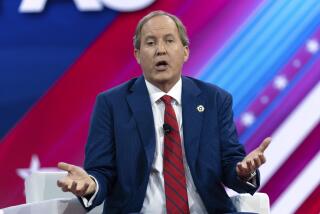Editorial: For sale: U.S. citizenship, $500,000 to $1 million
Depending on how you look at it, a federal immigration program that offers foreign investors a shortcut to naturalization is either tantamount to selling American citizenship or a shrewd tactic to draw job-creating investments from overseas. In reality, it’s a bit of both, and as a key part of the program comes up for reauthorization in the next few weeks, Congress needs to make some fundamental changes or kill it altogether.
The EB-5 (short for Employment-Based Fifth Preference Immigrant Investor) visa program began a quarter of a century ago as the federal government was looking for ways to spur foreign investment. The Immigration Act of 1990 — the last time Congress overhauled the immigration system — reserves up to 10,000 EB-5 visas each year for immigrants who invest at least $1 million, or $500,000 in high unemployment or rural areas, to create or preserve at least 10 jobs. In return, the investor (plus a spouse and children) receives a two-year conditional green card that, if the job-creation goal is reached, can be converted into permanent resident status with a path to citizenship.
The poorly conceived structure of the regional centers lets investors withdraw their money in two years, once they’ve received their Lawful Permanent Resident status.
The program bombed at first, with only a few hundred people applying — in part because of the complicated application and verification process, and in part because few people knew the visas existed. So in 1993, Congress started the Regional Center Pilot Program, which allowed local governments and businesses to create investment pools using money provided by EB-5 visa holders. Instead of individual investors launching or reviving businesses themselves, they could simply toss a check in the investment pool and count whatever jobs were created as proof that they had, indeed, put the requisite number of people to work. The program floundered until the last recession, after which privately owned regional centers exploded, growing from 74 in 2009 to 697 this year. The government hit its 10,000-visa limit for the first time in 2014, driven in part by regional centers pursuing foreign investors.
Although that sounds like good news, the results have been mixed. That’s largely because the government fails to track investments and their impact on communities, its regulations make it too easy to game the system, and the poorly conceived structure of the regional centers lets investors withdraw their money in two years, once they’ve received their Lawful Permanent Resident status.
The Government Accountability Office and Homeland Security’s Office of the Inspector General have criticized the program for lack of accountability and oversight, problems rooted in how Congress designed it. As of May, the government was investigating 59 cases of suspected fraud involving the regional centers. Among the stickier accountability issues: The government has limited means to verify whether the investment money is coming from legitimate business activities, and it’s not well equipped to measure the results of centers’ work. The agency that administers the program, U.S. Citizenship and Immigration Services, is geared toward enforcing immigration law, not analyzing economic development, and the enabling legislation requires limited record keeping. So no one can say with any authority how much investment and how many jobs the centers have spawned. The Bipartisan Policy Center think tank estimates, conservatively, that $4.2 billion of investment by the centers has produced 77,150 jobs (both direct and indirect — for example, the workers hired not just at a factory funded by investors but also at the doughnut shop next door where those workers eat).
Sen. Dianne Feinstein (D-Calif.) has called for ending the regional center program, whose authorization lapses Dec. 11. Others, such as Sen. Patrick Leahy (D-Vt.) and Sen. Charles E. Grassley (R-Iowa), have proposed an overhaul they say would address many of these problems and shore up oversight, including using investor fees for an “EB-5 Integrity Fund” to audit the regional centers. If Congress adopts such reforms, the program may be worth saving. Leahy’s interest, in fact, is based on the success of the Vermont’s EB-5 regional center, which has attracted $563 million to help finance 15 projects within the state. A similar government-run center could be a useful investment mechanism for Los Angeles to find money for hard-to-fund affordable housing projects.
But the program clearly needs an overhaul. For instance, the private firms that get federal permission to create regional centers design their own districts, which Feinstein’s office argues has led to gerrymandering by tethering high-unemployment neighborhoods to wealthy ones. Remember, EB-5 visas are available for $500,000 invested in high-unemployment or rural areas; otherwise, the investment must be $1 million. So the gerrymandering allows wealthy immigrants to gain Legal Permanent Resident status by making what amounts to a two-year, $500,000 loan to an investment pool building a high-end hotel in a ritzy part of town that is connected, on paper, to a neighborhood with more risk and a higher need for investment. It’s hard in that scenario not to see the program the way Feinstein does — as selling citizenship.
The process moves quickly, requiring only about six months for initial approval of the EB-5 visa. Contrast that with the millions of applicants of lesser means who have been waiting years for other employment-based or family-related visas (it varies radically depending on the country of origin because of varying visa allotments per country). Foreign investment in the U.S. is valuable, but EB-5 visa holders account for a sliver at best of the $150 billion to $200 billion that investors pour into this country. Congress needs to weigh the worth of the individual investments, and the potential for solving the program’s structural problems, against the distasteful perception that the rich can buy their way to an American passport.
Follow the Opinion section on Twitter @latimesopinion and Facebook
More to Read
A cure for the common opinion
Get thought-provoking perspectives with our weekly newsletter.
You may occasionally receive promotional content from the Los Angeles Times.










